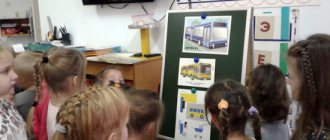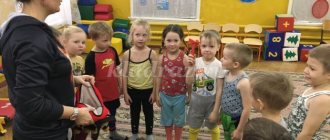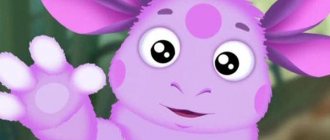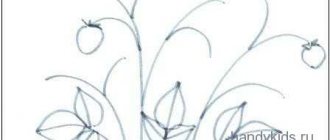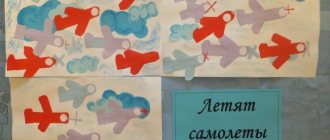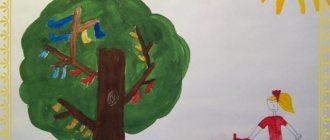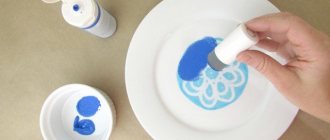Techniques and techniques that will be used in a drawing lesson in the senior group
The fairy tale captivates the child with a mysterious plot, immerses him in the world of thoughts and feelings of the heroes, their fates are remembered for a long time, every time the children seem to overcome obstacles anew, experience adventures together with their favorite fairy-tale characters. Almost all topics related to the illustration of fairy tales cannot be done without depicting a human or animal figure, which is part of the plot composition of the drawing. Depicting a living character is not easy for children, since older preschoolers are given more complex tasks, which involve moving away from simplified schematism and reinforce in children the desire to convey their thoughts, observations, and life experiences in the drawing.
Drawing tasks on fairy tale themes:
- continue to introduce students to Russian folk and literary fairy tales;
- teach children to embody their ideas in drawings, convey images of heroes and impressions of a fairy tale they heard;
- develop the ability to draw human and animal figures according to a diagram, learn to convey simple movements (turning and tilting the head, raised and bent arms, step) without violating the proportions;
- develop the skills of independently selecting material for an image, as well as an episode from a fairy tale plot, constructing a composition across an entire sheet of paper, correctly placing characters and objects in space;
- learn to create a pencil sketch that precedes the stage of coloring with pencils or paints;
- teach to convey the characteristic features of characters, their mood;
- improve the ability to draw with pencils, felt-tip pens, watercolors and gouache paints, mix colors to obtain the desired shade.
Children learn to embody an artistic concept in a drawing and convey their impressions of a winter fairy tale.
Types of drawing:
- Subject - a single image of a fairy-tale character or object, for example, Thumbelina, Kolobok, Winnie the Pooh, a hut on chicken legs, a magic castle, etc.
- Plot composition is a visual form of a story about any events or actions, built on the interaction of several characters and objects (“Masha and the Bear”, “Fox and the Hare”, “Geese-Swans”, etc.).
Classic techniques:
- Drawing with a simple pencil.
- Drawing with colored pencils.
- Drawing with wax crayons.
- Drawing with felt-tip pens.
- Drawing with charcoal and sanguine.
- Combined method (colored pencils and watercolors, felt-tip pens or wax crayons).
- Painting with a brush using gouache - the distinctive property of this material is its opacity, which allows you to overlap layers with a new color.
- Painting with a brush using watercolors. Children need to be taught the skills of regulating paint set, selecting colors, and softly conveying shades by mixing primary colors.
Children's works in classical techniques (photo gallery)
"The Ugly Duckling" (watercolor)
“My phone rang” (crayons and colored pencils)
Drawing “Stolen Sun” (gouache and felt-tip pens)
Drawing “I left my grandmother...” (colored pencils)
“The Fox and the Gingerbread Man” (watercolor)
“Thumbelina” (gouache and felt-tip pens)
“The Snow Queen” (wax crayons and markers)
Drawing “The Little Princess” (colored pencils and markers)
“Winter's Tale” (markers and colored pencils)
“Winter's Tale” (watercolors and markers)
Drawing for the fairy tale “The Little Princess” (wax crayons and felt-tip pens)
Drawing for the fairy tale “The Mouse and the Pencil” (wax crayons and felt-tip pens)
"The Ugly Duckling" (colored pencils)
“Geese-swans” (watercolor and gouache)
“Geese-swans” (watercolor)
“Geese-swans” (watercolor and felt-tip pens)
“Thumbelina” (felt pens)
Drawing “Water” (watercolor)
Drawing “Masha and the Bear” (colored pencils)
Drawing “Under the mushroom” (felt pens)
Drawing “Apple” (colored pencils)
Non-traditional techniques:
- Finger drawing - older preschoolers independently decide on the choice of theme for drawing, using finger techniques in combination with traditional techniques.
- Palm painting - based on children's handprints. Six-year-old children apply paint to their palm with a brush on their own, then complete the contours of the figure and draw in the details.
- Drawing on wet paper is a blurry, hazy image that is applied to a pre-moistened sheet of paper.
- Drawing using rock salt, semolina, colored sand. With the help of colored sand, interesting crafts are created by filling the silhouette, previously smeared with glue.
- Bleeding drawing - an image is drawn with wax crayons or a wax candle on white paper, then painted over with a top layer of watercolor in one or more color shades.
- Drawing with crumpled paper - drawing an image using a paper ball crumpled from a piece of paper.
- Pointillism (dot painting) - drawing with dots, dotted strokes using fingers, cotton swabs, cotton swabs, pencils with an eraser at the end or a brush.
- Stamping is an image of objects or natural phenomena by applying an imprint on paper using a stamp and stencil (foam rubber swab, wooden stamps, from vegetables, fruits, waste material, etc.).
- Vertical poke with gouache using a hard semi-dry brush without using water to obtain a visual texture effect (fluffiness, volume, relief).
- Scratching is scratching the outlines of a design onto a surface primed with wax or paint.
Children's works using non-traditional techniques (photo gallery)
“The Fox and the Gingerbread Man” (poke)
Drawing “Swan Princess” (pointillism)
Design of a blue petal (drawing with cotton swabs), green (poke)
Design of the sun (plastinography), blue petal (drawing) and violet (coming through pattern, drawing with a candle)
Drawing “Swan Princess” (pointillism)
Drawing “Swan Princess” (drawing with salt)
“Firebird” (leaf print and palm painting)
Drawing “Senor Rain” (drawing on wet)
Design of a red petal using a textured pattern technique (place a mesh and shade with a red pencil), an orange starfish (drawing with salt)
Drawing “Winnie the Pooh and his friends” (drawing with colored sand)
KVN “My Favorite Fairy Tales” senior group
KVN =
TOPIC: “MY FAVORITE TALES” Senior group. Educator: Sotieva A.V Program content:
- Reveal children's knowledge about fairy tales. Strengthen children's knowledge about fairy tales.
- Develop memory, thinking, observation, speech, vocabulary.
- Cultivate an interest in reading fairy tales, instill a love of fairy tales.
- Develop the ability to participate in competitions.
Equipment:
illustrations for various fairy tales, an exhibition of fairy tale books, hats for dramatizing fairy tales, various items from fairy tales.
Emblems, motto. Preliminary work:
reading fairy tales, games-dramatization of fairy tales.
Conducting evenings of riddles. KVN CONDUCT: The children entered the hall and said hello. (8-10 children). Educator:
Guys, I know you all really love games, songs, riddles, but do you like fairy tales
?
(Yes). Today I invite you to take a trip to the amazing land of fairy tales, would you like to?
(We want). You and I have read a lot of fairy tales and you all know that miracles and magic happen in fairy tales and a variety of heroes live there: they are both good and evil. But we also know that in a fairy tale what always wins? Of course - kindness and friendship. And today, to find out how well you know fairy tales, I suggest you play KVN. Do you agree? (Yes). To do this you need to split into two teams. You will compete in your knowledge of fairy tales. And at the end of KVN we will find out which team knows fairy tales better, who is more resourceful, smarter, friendlier, and more fun. As in all competitions, we have a jury that wants to look at you and find out how well you know fairy tales, what funny, friendly, smart, resourceful guys you are. Team 1—Golden Key (boys). Team 2 - “Thumbelina”.
(girls). Well?
Shall we begin? Take your seats at the tables. I wish you all good luck. KNOCKING ON THE DOOR.
Guys, someone is knocking on our door, do you hear?
Come in. Ole Lukoje enters. LEADING.
Hello.
Who you are? OLE-LUOYE.
Don't you recognize me?
I'm Ole-Lukoje. Fairytale gnome. No one in the world knows as many fairy tales as I know. I heard that a fairytale KVN will be held here today and wanted to know if your children really know fairy tales well. Can I stay with you? 1 HOST.
Certainly.
It's so good that you came. We are very glad to see you. Please sit down with the jury and look at our children. And at the end of KVN you will tell us your opinion. I think we won't disappoint you. And we begin. HOST:
KVN is a fun holiday, They say that he is a prankster.
But leprosy is not simple. You must think quickly. That's why we gathered the teams in this room. To find out at the finish line who should be first. Two tables at which children are sitting—each has a picture with the emblem 1. “Golden Key”, 2. “Thumbelina” attached to it. GREETING: 1 team. We are cheerful guys and we don’t like to be bored. will play
with pleasure .
2nd team
.
We are Thumbelina - hello, We are sending you an answer - Competing with you We will remain friends Let the struggle rage stronger Our friendship is stronger with her!
Guys, our
competition
begins with
the captains warming up. 1 Competition.
“Who knows fairy tales better?” The team whose captain answers the most questions will win the competition. We will determine this using chips. Questions are asked to the captains in turn. Questions:
- In childhood, this bird was called the ugliest and most ugly. And they called her...(ugly duckling).
- What name did the dog have in the fairy tale in which they lived: grandfather, grandmother, granddaughter, cat, mouse?……. (Bug).
- Who loved to brag about his song, and sang it to everyone he met along the way, and paid for it with his life?……..(Kolobok).
- What was the name of the girl who went into the forest to pick mushrooms and berries, got lost and walked into someone else's house? ……….(Mashenka).
- Who in the fairy tale had an ice hut?…….(the Fox). 2
- Which animal was the first to find the little house in the forest?…… (Mouse).
- What is the name of the kindest fairy-tale doctor?…..(Aibolit).
- What house was built by the smartest pig Naf-Naf?….(brick).
- In which fairy tale were they able to talk: a stove, an apple tree, a river?... (geese-swans).
- Which fairy-tale hero was cut out of a log?…..(Pinocchio).
COUNTING CHIPS.
Determination of the winner of the 1st competition 2nd competition. "FAIRY RIDDLES". Find out the name of the hero of the fairy tale. Riddles are solved one by one.
- A guy rides on the stove while eating rolls
I rode around the village and married the princess... (Emelya).
- Alyonushka's little brother was taken away by birds,
They fly high, they fly far... (Geese-swans, Ivanushka).
- Little girl runs merrily
Along the path to the house in the forest. This girl needs to quickly take the hot pies to her grandmother…….(Little Red Riding Hood).
- A girl appeared in a flower cup
And that girl was no bigger than a marigold. The girl slept in a nut shell, but she saved a big swallow from the cold..... (Thumbelina).
- Those who didn’t want to work, but played and sang songs
Then they ran to the third brother in a new house. They escaped from the gray wolf, but their tails shook for a long time..... (Piglets).
- They were waiting for mother with milk, but they let the wolf into the house
Who were these little children?…….(7 kids).
- He managed to catch a wolf, he caught a fox and a bear
He did not catch them with a net, but caught them with his barrel....(Tar barrel goby).
- Walking to school with an ABC book,
the wooden boy ends up in a linen booth instead of school. What is the name of this book, So is the name of the boy…….(Pinocchio).
- They ran away from dirty cups, spoons and pans,
She searches for x, calls, and sheds tears in sadness…….(Fedora).
- Sweet berry aroma
I lured those birds into the garden. Feathers glow with fire. And it’s as light in the night as during the day………………(Firebird). 3 3 competition “DISCOVER A FAIRY TALE BY ILLUSTRATION”.
The first team comes up to the board and the illustrations. They are invited to look at the illustrations. HOST: guys, they are asking for fairy tales - and now, you friends, get to know us. (show each team 5 pictures).
- But the road is long, and the basket is not easy, I wish I could sit on a stump and eat a pie. (Masha and the Bear).
- Oh, simplicity Petya, you made a little mistake, didn’t listen to the cat, looked out the window. (Cat, rooster and fox).
- This girl is sad, she doesn’t like spring, it’s hard for her in the sun, the poor thing sheds tears. (Snow Maiden).
- Is there not a river or a pond where you can drink water? Very tasty water in a puddle from the hoof. (Sister Alyonushka and brother Ivanushka).
- He is kinder than everyone in the world, he heals sick animals. And one day he pulled a hippopotamus out of the swamp. He is famous, famous, this is .....(Dr. Aibolit).
- If I stamp my foot, I will call my soldiers. A crowd of washbasins will fly into this room. And you will be washed clean, you will not be a chimney sweep. (Moidodyr).
- He pounded and pounded on the plate with his nose, did not swallow anything, and was left “with his nose.” (Fox and crane).
- He is both cheerful and not evil, he is a sweet eccentric. With him is the owner, the boy Robin and his friend Piglet. (Winnie the Pooh).
- The grandmother loved her granddaughter very much, the grandmother gave her a hat. The girl forgot her name, who can guess what her name was? (Little Red Riding Hood).
- She was born in a lovely flower, and fortunately her path was difficult, and everyone apparently guessed her name. (Thumbelina).
The competition is over - let's count the points.
FABULOUS CHARGING. (Physical minute). WAKE UP.
Beyond the fields, beyond the forests Beyond the wide seas Not in the sky - on earth An old man lived in a village. 1 exercise Such open spaces there! (Spread your arms to the sides) You want to go to the forest, but you want to go to the mountains. Exercise 2 Now let's go squat. What a nice exercise (Squats). Exercise 3 Raise your legs higher. Well, guys, don’t yawn. (Clapping underfoot). Exercise 4 As we swing the ax 4 The forest all around will make a noise You can only hear it all around - wow, wow (Lumberjacks). Exercise 5 Jump higher, jump further Develop your own self To become strong and agile. (Jumping). We played, now let's continue our KVN. While we were warming up, we received mail. These are telegrams. 4 COMPETITION. “NAME THE HERO OF THE FAIRY TALE WHO SENT THE TELEGRAM” according to the words, content:
- The beaten one is not lucky. (Fox).
- The fox took my house and kicked me out. Help. (Bunny).
- The wolf came and ate my brothers. Save them. (Kid).
- Thank you for saving me girl. (Martin).
- Eat my pie, then I’ll help you. (Stove).
- Who sat on my chair and broke it? (Mishutka).
- I left my grandmother and grandfather. I'll be with you soon. (Kolobok).
- We are not afraid of the gray wolf. (Piglets).
- Catch fish big and small. (Wolf).
- We need an axe, we will cook porridge with an axe. (Soldier).
Scoring.
Which team has more correct answers? 5 COMPETITION.
“WHAT FAIRY TALE ARE THE OBJECTS FROM AND TO WHOM DO THEY BELONG.” Guys, look, some kind of box.
Let's see what's in it. Oh it doesn't open. Maybe this is a magical fairytale chest? And do you have to say the magic words to open it? How many of you remember the magic words that wizards say? For example
: sim-sim open; sim-salabim; 1-2-3, unlock the lock; open up sesame; abracadabra. Well, the lock opened. Let's see what's here. I show the teams the objects one by one and they must name who the object belongs to and in which fairy tale it appears.
- Walnut shell. - Thumbelina.
- Rolling pin – Fox with a rolling pin.
- Pea - Princess and the Pea.
- A pot of honey - Winnie the Pooh.
- Glass slipper. Cinderella.
- The key is Pinocchio.
- Umbrella—Ole-Lukoje.
- An ax is a mess of an axe. 5
- Cow - Khavroshechka.
- Pike - At the behest of the pike.
- Dudochka - A pipe and a jug.
- Jug - fox and jug.
Scoring.
6 COMPETITION “COLLECT A PICTURE FROM PARTS.”
- Both teams collect picture from the fairy tale “The Three Little Pigs” from 8
parts. The team that collects it faster wins.
- Both teams by numbers collect a fabulous expression. 10 numbers—10 words. “The fairy tale is a lie, but there is a hint in it, a lesson for good fellows.”
7 COMPETITION. “FAIRY TALE COMPETITION” (Homework).
And now the teams will show you excerpts from fairy tales.
While the artists are preparing, a team member will tell you a brief summary of the tale. TEAM 1 - “Golden Key”, “Three Bears”.
Cups three and three beds.
There are also three chairs, look, and there are actually exactly three residents living here. As you see, it’s immediately clear: visiting them is (dangerous). But one day, trouble came, a girl came into that house. She got lost and couldn't find her way home. But the bears are coming home. What could happen here? Run away quickly, sister, fly out of the window like a (bird). She ran away! Well done! That's the end of the fairy tale. TEAM 2 – “Thumbelina”.
"Zayushina's hut." While the artists are preparing, a team member will tell you a brief summary of the tale.
Poem: The Bunny had a wonderful house, the Bunny lived well in it, but when spring came, the Fox came to his house. The Bunny was a kind little fellow and gave shelter to the Fox. And the Fox was angry 6 And she drove the Bunny away. Everyone wants to help him But the Fox drives everyone away Only Petya the Cockerel The Golden Comb Is not afraid of the Fox He carries a scythe on his shoulder. Again in his house the Bunny began to live with the Cockerel. HOST:
Our competitions are over.
And now we will listen to our jury. They will tell us which team was more attentive, more resourceful, and knows fairy tales better. We have petals. How many points the team has scored, so many petals are glued onto the circle. Petals 7. Whichever team collected the most petals, the team won. Presentation of diplomas for 1st place. Also awarding diplomas for 2nd place. Leading.
What do you say, dear Ole-Lukoje?
Do our children know fairy tales well? Ole-Lukoje.
Yes they are young.
They made me very happy. For this I give you gifts. Leading.
Thank you very much.
IOG. 1. Guys, do we need fairy tales? 2 Who lives in fairy tales? (Fairy-tale heroes). 3What are the heroes of fairy tales? (Good and evil). 4 What wins in fairy tales? (Good). 5 What do fairy tales teach us? (Kindness, honesty, courage, resourcefulness, they teach to be friends). 6 Did you like playing KVN?
Well, our KVN is over, thank you very much to everyone: the guys for participating, the Jury for their help, Ole-Lukoya for the gifts, and the audience for their attention.
Goodbye. 7 DIPLOMA 1st PLACE This Diploma was issued to the team__________________________ that took 1st place in the fabulous KVN “My Favorite Fairy Tales”.
By the decision of the jury, the team was awarded the title of a real resident of the country of DREAM, FANTASY and GOOD. Team member________________________Chairman of the jury_______________________ Members of the jury______________________________
Date________________________________ 8
DIPLOMA II PLACE This Diploma was issued to the team__________________________ that took second place in the fabulous KVN “My Favorite Fairy Tales”.
By the decision of the jury, the team was awarded the title of a real resident of the country of DREAM, FANTASY and GOOD. Team member___________________________Chairman of the jury___________________________ Members of the jury_________________________________
Date_________________________________ 9
Drawing techniques on the theme “My favorite fairy tale” for older preschoolers
Older preschoolers are actively improving their drawing techniques with pencils, crayons and felt-tip pens, since shading helps strengthen the muscles of the hand, develop fine motor skills and coordination of movements, and therefore helps prepare children for school stress.
- The line is the main method for sketching, which is taught to six-year-old children. A line can be of different lengths and rhythms and helps to depict a contour, conveying the nature of the object’s shape, its size, dynamics and proportions.
- Hatching is a fairly simple, but expressive and effective way of conveying the character of a character (lightness, heaviness, flexibility, plasticity, etc.) and the texture of an object. Drawing with strokes helps not only to reveal the image of an object, but also to develop fine motor skills, which is very important for solving the problem of preparing for writing. Types of shading:
- Chaotic - the strokes are laid in a free direction, then they are formed by additional contour drawing of the outlines of the object.
- Vertical - dense strokes are applied in a vertical direction. Using colored pencils with different pressure levels will allow you to get the effect of a smooth change of various shades.
- Diagonal - most popular in the landscape genre for depicting, for example, rain or silhouettes of mountains.
- Horizontal is a rather difficult technique to perform, since it requires the child to change the usual position of the hand during the drawing process.
- Shape-building is a technically complex and time-consuming way of conveying the shape of an object, for example, a cloud or the crown of a tree.
- Shading helps to achieve different degrees of color saturation depending on the degree of pressure of the pencil. Drawing an outline requires more pressure than painting the silhouette of an object or creating a background pattern.
- Dot, rhythmic stroke, brush stroke using the technique of painting with watercolors and gouache paints.
Organization and conduct of classes
The rich theme of “My Favorite Fairy Tale” is revealed in the process of versatile pedagogical work aimed at cognitive, speech, social-communicative, artistic and aesthetic development. Drawing classes can be conducted both in a narrowly focused format and within the framework of short-term and long-term projects on this topic (“Russian folk tales”, “Fairy tales of A. S. Pushkin”, “Tales of the peoples of the world”, “Fairy tales of H. H. Andersen” ", "Tales of Chukovsky", "Tales of V. Suteev", etc.).
Large plot compositions, which consist of several characters and objects, are usually created collectively. The preparatory stage, during which the background is tinted, individual figures are drawn, details are worked out, is carried out in small subgroups of 3-4 people, and then the children together compose a plot picture on whatman paper, gluing the silhouettes they have prepared, simultaneously developing spatial thinking abilities, gaining experience in coordinated actions. In the process of collective creativity, children rely on a condition set by the teacher or a free plan, improving the social skills of mutual understanding and camaraderie.
A Christmas Tale - working with elements of appliqué and plastinography
It is important to develop in children an understanding of the correct sequence of stages of work to create a collective plot composition or collage:
- make a background image divided by a horizon line;
- draw background objects (trees, sun, clouds, flowers, etc.);
- draw or place previously prepared and cut out silhouettes of fairy-tale characters.
Drawing of the Firebird - each child paints his own feather, then everyone collects the fluffy tail of a fairy-tale bird together
Lesson outline
The senior group has one drawing lesson per week. The total duration of continuous activity should not exceed 20–25 minutes; methodological manuals recommend performing physical exercises (finger, breathing, motor exercises) for 5 minutes to neutralize psychological and mental stress, as well as prevent physical fatigue in children.
- Organizational part (3–5 minutes). The practical part of the lesson can be preceded not only by reading a fairy tale or literary work, but also by viewing pictures, a slide show, a fragment of a film or cartoon. The informational and familiarization stage involves awakening children's interest in the fairy tale plot, studying the characters of the main characters and the sequence of events. It is necessary to include surprise moments, elements of theatrical play, stimulating curiosity, causing a positive emotional reaction and activity.
- Practical part - the teacher explains the sequence of creating a composition and drawing the main characters based on the diagram (3-5 minutes). Older preschoolers are given more freedom in the drawing process; showing a picture or sample prepared by the teacher should not be used for copying, but only to form a correct understanding of the task or clarify it. The work is done from life (toy) or based on the free design of children; the basic techniques have already been mastered, so they do not require additional demonstration.
- Independent work of children (15–20 minutes).
- The final part is the analysis and assessment by children of their works and the drawings of their comrades. Children are taught to formulate their point of view with reason and verbally express the aesthetic perception of creative works (3-5 minutes).
Schemes for drawing fairy-tale characters (photo gallery)
Princess
Clown
bear
Witch
Goat
Snow Maiden
The sequence of creating an illustration for the fairy tale about Kolobok
The Hare and the Bun Izbushka
Kolobok Piglet Winnie the Pooh
Lesson summary on the topic “Journey to a Fairy Tale” (author T. A. Sosik)
Goals: Continue to introduce children to oral folk art, consolidate children's knowledge of Russian folk tales. Tasks:
Materials: white paper, gouache, watercolor, brushes, wax crayons, illustrations for Russian folk tales. Didactic games: “Find out by profile”, “Match heroes from fairy tales”. 1. Organizational stage. Educator: At the beginning of the lesson, I want to read you a poem by V.A. Steklovoy There are many different fairy tales in the world, Sad and funny, But we cannot live in the world without them. In a fairy tale, anything can happen, Our fairy tales are ahead, A fairy tale will knock on the door - The guest will say: “Come in.” Today we will go on an unusual journey, to the land of fairy tales. A long time ago, people did not yet know how to read or write, but they were already telling fairy tales. And how they loved to listen to them, and not only small children, but also adults. They will gather in the evening for gatherings: logs are crackling in the stove, the hut is crowded, everyone is busy, some are spinning yarn, some are knitting, some are embroidering, and some are just listening to a fairy tale. The fairy tale has survived to this day, because it was told from generation to generation, passed on from mouth to mouth. Your grandmothers told the story to your mothers and fathers, your mothers told you, and you tell it to your children. This is how a fairy tale came to us from ancient times. What fairy tales do you know? Answers: “Kolobok”, “Teremok”, “Three Bears”, “Geese-Swans”, etc. What kind of fairy tales are these? (Russian folk) Why are they called that? Answers: (Created and written by the people). Didactic games “Find out by profile” and “Match heroes to fairy tales” are held. - Well done! - Guys, do you have any favorite fairy tales? Answers. These are the heroes of these fairy tales that we will draw with you. Selected fairy tale characters (illustrations) are placed on a flannelgraph. 2. Practical part. Look carefully at the heroes of fairy tales and you will see how different they are. The art of portraiture is very ancient. When painting a portrait, artists try to convey the character and inner world of the hero. Fairy-tale heroes can be cunning and gullible, good and evil. But we are all artists in our own way. Let's draw illustrations for our favorite fairy tales. We must try to convey in the portrait the character of the hero, his characteristic features, and moods. Don't forget about your hairstyle, jewelry, and hats. All the little things are important. They also talk about the character of the hero. You have to work very carefully and carefully. What do you think is the ending of the fairy tale? Answers (Always happy, good conquers evil). Right! Well, now let's get to work. 3. Independent work. Children draw. 4. Summing up. After the lesson, the teacher hangs all the drawings in a visible place - the children look at them and tell what fairy-tale character they drew, discuss the characters’ characters, what they are like. |
Summary of a lesson on artistic creativity, on the topic: “Fairyland” (senior group)
Notes
on artistic creativity in non-traditional drawing techniques “wax crayons + watercolor”.
Topic:
“Fairytale Country” (based on Russian folk tales) (senior group)
Integration of educational areas:
“Artistic creativity”, “Cognition”, “Physical education”, “Communication”, “Reading fiction”, “Music”.
Goal:
To improve children's drawing skills using non-traditional methods.
Objectives:
Educational:
1. Systematize children’s knowledge about Russian folk tales. 2. Improve the skills of non-traditional depiction using the “wax crayons + watercolor” technique.
Educational:
1. To develop in children the desire to share their impressions of the content of the fairy tale through unconventional drawing with wax crayons and watercolors. 2. Develop speech and cognitive activity, imagination, fantasy, auditory perception. 3. Develop children’s ability to work amicably and coordinatedly in a small team. 4. Improve gross motor skills.
Educational:
- Cultivate interest in Russian folk tales.
- Cultivate a caring attitude towards every job.
- Cultivate neatness.
Material:
- Base (sheet A-3) - according to the number of pairs of children (white background).
- Hearts (cut into two parts) with written text of excerpts from fairy tales.
- Books – Russian folk tales.
- Wax crayons, watercolors, brushes, napkins - according to the number of children.
- The cover is a drawing for a children's book.
- Clew.
- Cut-out pictures based on fairy tales.
- Audio recording - Dmitry Shostakovich Prelude No. 5.
Lesson plan:
- Set up for class.
- Communication.
- Game "Give me a word."
- Communication.
- Game "Name a fairy tale with a magic ball."
- Game "Collect a fairy tale."
- Game “Whose words are these?”
- Communication.
- Physical education minute “Fairy tales”.
- Communication.
- Finger gymnastics “Favorite Tales”.
- Drawing. / Communication.
- Summary of the lesson.
Progress of the lesson:
- Mood for class
Educator: Hello, guys! Let's all stand in a circle and say together: All the children have gathered in a circle (stand in a circle), I am your friend and you are my friend (show), Let's hold hands together (hold hands), And smile at each other (smile) . 2 .
Communication
Teacher: Guys, do you like fairy tales? Why? (Children's expected answers: they are interesting, we have been listening to them since birth, in fairy tales good defeats evil, animals talk, there is magic, there are miracles, there is Baba Yaga, Koschey, the Serpent Gorynych). 3. Game “Give me a word”
Educator: Guys, how can you say about a fairy tale, what is it like? (If there is a miracle in a fairy tale, then it is...wonderful, if there is magic in a fairy tale, then it is...magical, if there is good in a fairy tale, then it is...kind, if there is joy in a fairy tale, then it is...joyful, if there are riddles in a fairy tale , then she is...mysterious, if there is wisdom in a fairy tale, then she is...wise).
4.Communication
Educator: Guys, what kind of fairy tales are there? (Expected answers from children: author's, folk, literary). Tell me, what does “Russian folk” mean? Why are they called that? (Children's answers: they were composed by the Russian people).
5. Game “Name the fairy tale with the magic ball”
Educator: Guys, do you know Russian folk tales? (Children's answers) Now let's check. In many Russian folk tales there is a magical object that shows the way for the heroes. Do you remember what this item is? (Children's answers) That's right. This is a magic ball. Here he is. But somehow he got unraveled. We will now pass the ball to each other, wind the thread and name the fairy tale. (Children's answers).
6. Game “Collect a fairy tale”
Educator: Guys, you know fairy tales, but can you collect and recognize them from the resulting pictures? (Children's answers) Now let's see (Collect a fairy tale from cut-out pictures).
7. Game “Whose words are these”
Educator: Guys, you collected fairy tales and learned them from the resulting pictures. And guess whose words these are? (Frequently repeated words of heroes from the fairy tales “Kolobok”, “Masha and the Bear”, “At the Pike’s Command”, “The Fox and the Hare”, etc.)
8. Communication
Educator: Guys, they say about a fairy tale: “A fairy tale is a lie, but there is a hint in it, a lesson for good fellows!” What does a fairy tale teach? (Children's expected answers: kindness, help each other, live together, etc.)
9. Physical education minute “Fairy Tales” (conducted by children)
1. The mouse ran quickly (running in place), the mouse wagged its tail (imitation of movement). Oh, I dropped an egg (they bend down to pick up the “egg”), Look, I broke it (they show).
2. Here we planted it (lean over), and poured water on it (imitation of movement). The turnip has grown - good and strong (they spread their arms to the sides). Now let’s pull it (pull), and cook porridge from the turnip (imitation food). And we will be healthy and strong from the turnip (showing “strength”).
3.We are a nice family of little goats. We love to jump and gallop (bounce on the spot). We love to run and play (run). We love to butt heads with horns (show horns, butt).
10.Communication
Educator: Guys, today I received an invitation to a fairyland where Russian folk tales live (I show the invitation in the form of a heart on which it says “Create a fairyland”). Would you like to visit there and create it from drawings? (Children's answers) In this envelope there are invitations for you, even your names are written (I show the children hearts cut in half in different directions). If you connect the hearts correctly, i.e. When you find your pair, you will find out which fairy tale your pair will end up in, and decide together what you will draw based on the content of the fairy tale. And then we will all create the book “Fairytale Land” together. (Children get into pairs, learn their fairy tale and agree that they will draw) Guys, we will draw with wax crayons and watercolors, but first we will stretch our fingers.
11. Finger gymnastics “Favorite fairy tales”
Let's count our fingers, Let's call fairy tales (they clench and unclench their fists): “Mitten”, “Teremok”, “Kolobok” - ruddy side. There is “Snow Maiden” - beauty, “Three Bears”, “Wolf and Fox”. Let's not forget Sivka-Burka, our prophetic kaurka. We know the fairy tale about the Firebird, we don’t forget “Turnip”, We know “The Wolf and the Little Goats” (they bend a finger at each name). Everyone is happy about these fairy tales (clap their hands).
12. Drawing / Communication
Children draw in pairs, independently dividing the amount of work to be done. If necessary, I ask clarifying and guiding questions.
13. Lesson summary
Educator: Guys, let's exchange pages with each other and determine who “traveled” in which fairy tale in Fairytale Land (children in pairs exchange works, analyze the content of the drawing). Look, here's the cover for the book. Let's put your drawings on the cover and create a book “Fairytale Land” (put the drawings on the cover and look at the resulting book).
